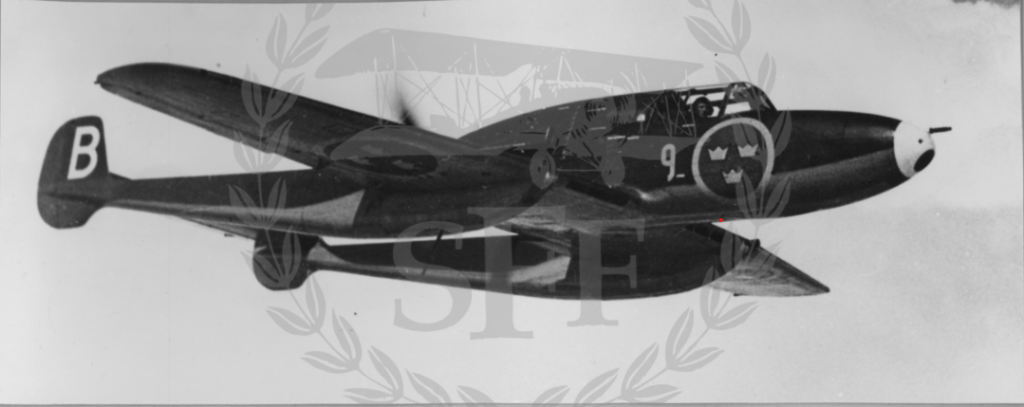
Airplane J 21. Image from the Swedish Aviation History Association.
SAAB J21 at F9
In this diorama, we have taken a certain “artistic freedom” at the expense of the historically correct. In order for visitors to recognize where it is, we have placed today’s traffic control tower on the mountain in the background. In reality, this tower did not exist at the time when the air flotilla was equipped with J 21s. In 1946 the F9’s FFVS J 22s were replaced by the SAAB J 21, which then served in the flotilla until 1950 when it was replaced by the J 28B De Havilland Vampire. A total of 107 J 21s have been on the F9, though not all at the same time.
The SAAB J 21 was an unconventional design with the engine positioned behind the pilot and with a firing propeller positioned between two tail booms. The advantage of this arrangement was that all the armament could be concentrated in the nose. However, it also brought some disadvantages. For example. air flow to the coolers became low when idling on the ground and when taxiing, which often led to overheating of the engine. With the propeller behind the pilot, a “normal” parachute jump from the aircraft became impossible, as the propeller would then likely shred the pilot. Therefore, the J 21 became the first Swedish aircraft, and one of the first in the world, to be equipped with a catapult seat.
The first flight of the J 21 was made on 30 July 1943, and on 1 December the first aircraft were taken into operational service at F8 Barkarby outside Stockholm. It soon became apparent that the J 21’s performance, especially its top speed, was too poor for a fighter aircraft. It was instead used with good results as an attack aircraft, then with the designation A 21. During the years 1945 to 1949, a total of 298 J 21 and A 21 were manufactured. The aircraft type was taken out of service in the Air Force in July 1954.
Some data on J 21.
Crew: 1 person.
Length: 10.45m
Span: 11.6 m
Engine: Daimler Benz DB 605B of 1455 hp.
Max take-off weight: 5,200 kg
Maximum speed: 650 km/h
Peak Elevation: 10,200m
Armament: One 20 mm cannon and two 13.2 mm machine guns in the nose and two 13.2 mm machine guns in the wings. A 21 could also take 12 15 cm rockets and a bomb of maximum 600 kg.
